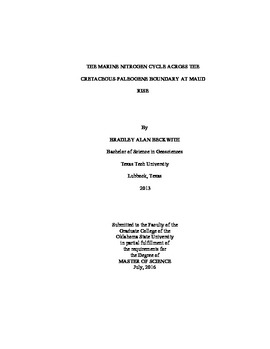| dc.contributor.advisor | Quan, Tracy M. | |
| dc.contributor.author | Beckwith, Bradley | |
| dc.date.accessioned | 2017-02-22T22:13:48Z | |
| dc.date.available | 2017-02-22T22:13:48Z | |
| dc.date.issued | 2016-07-01 | |
| dc.identifier.uri | https://hdl.handle.net/11244/49045 | |
| dc.description.abstract | The marine nitrogen cycle across the Cretaceous-Paleogene (K-Pg) boundary at Maud Rise provides insight into an important environmental variable during the K-Pg extinction event, the redox state of the water column. This is because reactions in the marine nitrogen cycle are redox dependent, and evidence of them is preserved within the organic matter (OM) deposited and buried within the sediments. We evaluated the sedimentary nitrogen stable isotope ratio (?15N) values across the K-Pg boundary at Maud Rise, a seamount at a high latitude location in the Southern Ocean (65�9.621'S; 1�12.285'E), and can relate the severity and length of recovery period at Maud Rise to variations in the water column redox state. We digested the calcareous ooze core samples recovered from Maud Rise (Ocean Drilling Program Site 690) in 30% HCl to remove carbonate, and then obtained our ?15N values using an Elemental Analyzer (EA) interfaced to an Isotope Ratio Mass Spectrometer (IRMS). We also collected sedimentary organic carbon stable isotope ratio (?13Corg) values and the elemental concentrations of nitrogen (N) and carbon (C) of the decarbonated sediment fraction with this method. Our ?15N values indicate that oxic conditions prevailed at Maud Rise through the reddish-brown marl interval of the core following the K-Pg boundary, and that Maud Rise was oxic or suboxic through the Late Cretaceous, early Paleocene and late Paleocene intervals analyzed in this study. Cross-plots of our ?13Corg values and C/N ratios indicate the primary source of OM at Maud Rise was from marine phytoplankton, with some contribution from C3 land plants. The oxic conditions contributed to the more rapid recovery of calcifying plankton at Maud Rise in comparison to mid and low latitude locations, because surviving/existing taxa were already adapted to the oxic water column conditions at Maud Rise, an important environmental variable. | |
| dc.format | application/pdf | |
| dc.language | en_US | |
| dc.rights | Copyright is held by the author who has granted the Oklahoma State University Library the non-exclusive right to share this material in its institutional repository. Contact Digital Library Services at lib-dls@okstate.edu or 405-744-9161 for the permission policy on the use, reproduction or distribution of this material. | |
| dc.title | Marine Nitrogen Cycle Across the Cretaceous-paleogene Boundary at Maud Rise | |
| dc.contributor.committeeMember | Atekwana, Eliot A | |
| dc.contributor.committeeMember | Pashin, Jack C | |
| osu.filename | Beckwith_okstate_0664M_14799.pdf | |
| osu.accesstype | Open Access | |
| dc.description.department | Geology | |
| dc.type.genre | Thesis | |
| dc.type.material | text | |
